
Night vision goggles
Encyclopedia
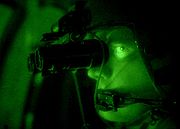
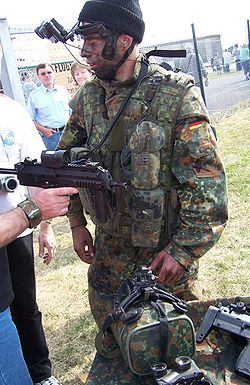
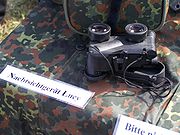
Optical instrument
An optical instrument either processes light waves to enhance an image for viewing, or analyzes light waves to determine one of a number of characteristic properties.-Image enhancement:...
that allows images to be produced in levels of light approaching total darkness. They are most often used by the military
Night combat
Night combat is combat that occurs during the hours of darkness. It is distinguished from daytime combat by lower visibility and its reversed relation to the Circadian cycle. Typically combat at night is favorable to the attacker, with offensive tactics being focused on exploiting the advantages...
and law enforcement
Police
The police is a personification of the state designated to put in practice the enforced law, protect property and reduce civil disorder in civilian matters. Their powers include the legitimized use of force...
agencies, but are available to civilian
Civilian
A civilian under international humanitarian law is a person who is not a member of his or her country's armed forces or other militia. Civilians are distinct from combatants. They are afforded a degree of legal protection from the effects of war and military occupation...
users. The term usually refers to a complete unit, including an image intensifier
Image intensifier
An image intensifier tube is a vacuum tube device for increasing the intensity of available light in an optical system to allow use under low light conditions such as at night, to facilitate visual imaging of low-light processes such as fluorescence of materials to X-rays or gamma rays, or for...
tube, a protective and generally water-resistant housing, and some type of mounting system. Many NVDs also include sacrificial lenses, IR illuminators, and telescopic lens
Optical telescope
An optical telescope is a telescope which is used to gather and focus light mainly from the visible part of the electromagnetic spectrum for directly viewing a magnified image for making a photograph, or collecting data through electronic image sensors....
es.
Night vision
Night vision
Night vision is the ability to see in low light conditions. Whether by biological or technological means, night vision is made possible by a combination of two approaches: sufficient spectral range, and sufficient intensity range...
devices were first used in World War II
World War II
World War II, or the Second World War , was a global conflict lasting from 1939 to 1945, involving most of the world's nations—including all of the great powers—eventually forming two opposing military alliances: the Allies and the Axis...
, and came into wide use during the Vietnam War
Vietnam War
The Vietnam War was a Cold War-era military conflict that occurred in Vietnam, Laos, and Cambodia from 1 November 1955 to the fall of Saigon on 30 April 1975. This war followed the First Indochina War and was fought between North Vietnam, supported by its communist allies, and the government of...
. The technology has evolved greatly since their introduction, leading to several "generations" of night vision equipment with performance increasing and price decreasing. Another term is "night optical device" or NOD.
Generations
The classification below was initially introduced by the US manufacturers through the US government. European manufacturers do not abide by it.Generation 0
The first practical commercial night visionNight vision
Night vision is the ability to see in low light conditions. Whether by biological or technological means, night vision is made possible by a combination of two approaches: sufficient spectral range, and sufficient intensity range...
device offered on the market was developed by Dr. Vladimir K. Zworykin working for the Radio Corporation of America and was intended for civilian use. At that time infra-red was commonly called black light
Black light
A black light, also referred to as a UV light, ultraviolet light, or Wood's lamp, is a lamp that emits ultraviolet radiation in the long-wave range, and little visible light...
, a term later restricted to Ultraviolet
Ultraviolet
Ultraviolet light is electromagnetic radiation with a wavelength shorter than that of visible light, but longer than X-rays, in the range 10 nm to 400 nm, and energies from 3 eV to 124 eV...
. It was not a success due to its size and cost. The first military night vision device were introduced by the German army as early as 1939. The first devices were being developed by AEG
AEG
Allgemeine Elektricitäts-Gesellschaft was a German producer of electrical equipment founded in 1883 by Emil Rathenau....
starting in 1935. By the end of World War II, the German army had equipped approximately 50 Panther tank
Panther tank
Panther is the common name of a medium tank fielded by Nazi Germany in World War II that served from mid-1943 to the end of the European war in 1945. It was intended as a counter to the T-34, and to replace the Panzer III and Panzer IV; while never replacing the latter, it served alongside it as...
s, which saw combat on both the Eastern
Eastern Front (World War II)
The Eastern Front of World War II was a theatre of World War II between the European Axis powers and co-belligerent Finland against the Soviet Union, Poland, and some other Allies which encompassed Northern, Southern and Eastern Europe from 22 June 1941 to 9 May 1945...
and Western Front
Western Front (World War II)
The Western Front of the European Theatre of World War II encompassed, Denmark, Norway, Luxembourg, Belgium, the Netherlands, France, and West Germany. The Western Front was marked by two phases of large-scale ground combat operations...
s. The "Vampir" man-portable system
Zielgerät 1229
The Zielgerät 1229 , also known in its code name Vampir, was an active infrared device developed for the Wehrmacht for the Sturmgewehr 44 assault rifle, intended primarily for night use.-Design:...
for infantrymen was being used with Sturmgewehr 44
Sturmgewehr 44
The StG 44 was an assault rifle developed in Nazi Germany during World War II and was the first of its kind to see major deployment, considered by many historians to be the first modern assault rifle...
assault rifles.
Parallel development of night vision systems occurred in the USA. The M1 and M3 infrared night sighting devices, also known as the "sniperscope" or "snooperscope", were introduced by the US Army in World War II
World War II
World War II, or the Second World War , was a global conflict lasting from 1939 to 1945, involving most of the world's nations—including all of the great powers—eventually forming two opposing military alliances: the Allies and the Axis...
, and also used in the Korean War
Korean War
The Korean War was a conventional war between South Korea, supported by the United Nations, and North Korea, supported by the People's Republic of China , with military material aid from the Soviet Union...
, to assist sniper
Sniper
A sniper is a marksman who shoots targets from concealed positions or distances exceeding the capabilities of regular personnel. Snipers typically have specialized training and distinct high-precision rifles....
s. They were active devices, using a large infrared light source to illuminate targets. Their image intensifier tubes function using an anode
Anode
An anode is an electrode through which electric current flows into a polarized electrical device. Mnemonic: ACID ....
and an S-1 photocathode
Photocathode
A photocathode is a negatively charged electrode in a light detection device such as a photomultiplier or phototube that is coated with a photosensitive compound...
, made primarily of silver
Silver
Silver is a metallic chemical element with the chemical symbol Ag and atomic number 47. A soft, white, lustrous transition metal, it has the highest electrical conductivity of any element and the highest thermal conductivity of any metal...
, caesium
Caesium
Caesium or cesium is the chemical element with the symbol Cs and atomic number 55. It is a soft, silvery-gold alkali metal with a melting point of 28 °C , which makes it one of only five elemental metals that are liquid at room temperature...
, and oxygen
Oxygen
Oxygen is the element with atomic number 8 and represented by the symbol O. Its name derives from the Greek roots ὀξύς and -γενής , because at the time of naming, it was mistakenly thought that all acids required oxygen in their composition...
and a electrostatic inversion with electron acceleration were used to achieve gain .
Generation 1 (GEN I)
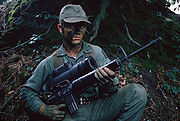
Vietnam War
The Vietnam War was a Cold War-era military conflict that occurred in Vietnam, Laos, and Cambodia from 1 November 1955 to the fall of Saigon on 30 April 1975. This war followed the First Indochina War and was fought between North Vietnam, supported by its communist allies, and the government of...
, were an adaptation of earlier active GEN 0 technology, and rely on ambient light instead of an infrared light source. Using an S-20 photocathode
Photocathode
A photocathode is a negatively charged electrode in a light detection device such as a photomultiplier or phototube that is coated with a photosensitive compound...
, their image intensifiers produce a light amplification of around 1,000×, but are quite bulky and require moonlight
Moonlight
Moonlight is the light that reaches Earth from the Moon. This light does not originate from the Moon, but from sunlight. The Moon does not, however, reflect sunlight like a mirror, but it reflects light from those portions of its surface which the Sun's light strikes. See diffuse reflection.In...
to function properly.
Examples:
- AN/PVS-2 Starlight scope
Generation 2 (GEN II)
Second generation devices feature an improved image-intensifier tube utilizing micro-channel plate (MCP) with an S-25 photocathodePhotocathode
A photocathode is a negatively charged electrode in a light detection device such as a photomultiplier or phototube that is coated with a photosensitive compound...
, resulting in a much brighter image, especially around the edges of the lens. This leads to increased illumination in low ambient light environments, such as moonless nights. Light amplification is around 20,000×. Also improved were image resolution
Image resolution
Image resolution is an umbrella term that describes the detail an image holds. The term applies to raster digital images, film images, and other types of images. Higher resolution means more image detail....
and reliability
Reliability engineering
Reliability engineering is an engineering field, that deals with the study, evaluation, and life-cycle management of reliability: the ability of a system or component to perform its required functions under stated conditions for a specified period of time. It is often measured as a probability of...
.
Examples:
- AN/PVS-4AN/PVS-4AN/PVS-4 is the U.S. military designation for a specification of the first second generation passive Night vision device....
- AN/PVS-5
- SUPERGEN
Later advancements in GEN II technology brought the tactical characteristics of "GEN II+" devices (equipped with better optics, SUPERGEN tubes, improved resolution and better signal-to-noise ratio
Signal-to-noise ratio
Signal-to-noise ratio is a measure used in science and engineering that compares the level of a desired signal to the level of background noise. It is defined as the ratio of signal power to the noise power. A ratio higher than 1:1 indicates more signal than noise...
s) into the range of GEN III devices, which has complicated comparisons.
Generation 3 (GEN III)
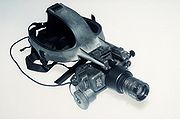
Night vision
Night vision is the ability to see in low light conditions. Whether by biological or technological means, night vision is made possible by a combination of two approaches: sufficient spectral range, and sufficient intensity range...
systems maintain the MCP from Gen II, but now use a photocathode made with gallium arsenide, which further improves image resolution. In addition, the MCP is coated with an ion barrier film for increased tube life. However, the Ion barrier causes less electrons to pass through, diminishing the improvement the Gallium arsenide should give. Because of the Ion barrier, the "halo"effect around bright spots or light sources is larger too. The light amplification is also improved to around 30,000–50,000×. Power comsumption is higher than GEN II tubes.
Examples:
- AN/PVS-7
- AN/NVS-7
- AN/PVS-10
- AN/PVS-14AN/PVS-14The AN/PVS-14 Monocular Night Vision Device is in widespread use by US Armed Forces as well as NATO allies around the world. It uses a third generation image intensifier tube, and is manufactured by Litton Industries as well as the ITT Corporation...
- AN/PNVS-14
- CNVS-4949
Omnibus-VII (GEN III+ or GEN IV)
US Army Night Vision and Electronic Sensors Directorate (NVESD) is part of the governing body that dictates the name of the generation of night visionNight vision
Night vision is the ability to see in low light conditions. Whether by biological or technological means, night vision is made possible by a combination of two approaches: sufficient spectral range, and sufficient intensity range...
technologies. Although the recent increased performance associated with the GEN-III OMNI-VII components is impressive, the US Army has not yet authorized the use of the name GEN-IV for these components.
GEN-III OMNI-VII devices can differ from standard Generation 3 in two important ways. First, an automatic gated power supply
Power supply
A power supply is a device that supplies electrical energy to one or more electric loads. The term is most commonly applied to devices that convert one form of electrical energy to another, though it may also refer to devices that convert another form of energy to electrical energy...
system regulates the photocathode voltage, allowing the NVD to instantaneously adapt to changing light conditions. The second is a removed or greatly thinned ion barrier, which decreases the amount of electrons that are usually rejected by the Standard GEN III MCP, hence resulting in less image noise and the ability to operate with a luminous sensitivity at 2,850 K of only 700, compared to operating with a luminous sensitivity of at least 1,800 for GEN III image intensifiers. The disadvantage to a thin or removed ion barrier is the overall decrease in tube life from a theoretical 20,000 hrs mean time to failure (MTTF) for Gen III type, to 15,000 hrs MTTF for GEN IV type. However, this is largely negated by the low numbers of image intensifier tubes that reach 15,000 hrs of operation before replacement.
It is important to note that while the consumer market classifies this type of system as Generation 4, the United States military describes these systems as Generation 3 Autogated tubes (GEN-III OMNI-VII). Moreover, as autogating power supplies can now be added to any previous generation of night vision, "autogating" capability does not automatically class the devices as a GEN-III OMNI-VII, as seen with the XD-4. Another point to note is that any postnominals appearing after a Generation type (i.e., Gen II +, Gen III +) do not change the generation type of the device, but instead indicates an advancement(s) over the original specification's requirements.
Examples:
- AN/PVS-22AN/PVS-22The AN/PVS-22 or Universal Night Sight is a Picatinny rail mounted in-line night sight designed and manufactured by FLIR Systems and issued with the existing telescopic sight or red dot sight. It can be added to any weapon that uses a Picatinny rail and has an existing scope, simply mounting in...
- NVS-22
Figure of merit
Though image intensification technology employed by different manufacturers varies, from the tactical point of view night visionNight vision
Night vision is the ability to see in low light conditions. Whether by biological or technological means, night vision is made possible by a combination of two approaches: sufficient spectral range, and sufficient intensity range...
system is an optical device that enables vision at low light. The US government itself has recognized the fact that technology itself makes little difference as long as an operator can see clearly at night. Consequently the United States bases export regulations not on the generations, but on a calculated factor called figure of merit
Figure of merit
A figure of merit is a quantity used to characterize the performance of a device, system or method, relative to its alternatives. In engineering, figures of merit are often defined for particular materials or devices in order to determine their relative utility for an application...
(FOM). The method of FOM calculation and its implications for export are briefly described in a National Defense University
National Defense University
The National Defense University is an institution of higher education funded by the United States Department of Defense, intended to facilitate high-level training, education, and the development of national security strategy. It is chartered by the Joint Chiefs of Staff, with Navy Vice Admiral...
document called “The NATO Response Force” authored by Jeffrey P. Bialos, the Executive Director of the Transatlantic Security and Industry Program at the Johns Hopkins University and Stuart L. Koehl, a Fellow at the Center for Transatlantic Relations of the same university.
US-made tubes with a FOM greater than 1,400 are not exportable outside the US.
Other technologies

United States Air Force
The United States Air Force is the aerial warfare service branch of the United States Armed Forces and one of the American uniformed services. Initially part of the United States Army, the USAF was formed as a separate branch of the military on September 18, 1947 under the National Security Act of...
is experimenting with panoramic night vision goggles (PNVGs) which double the user's field of view
Field of view
The field of view is the extent of the observable world that is seen at any given moment....
to around 95 degrees by using four 16 mm image intensifier tubes, rather than the more standard two 18 mm tubes. They are in service with A-10 Thunderbolt II
A-10 Thunderbolt II
The Fairchild Republic A-10 Thunderbolt II is an American single-seat, twin-engine, straight-wing jet aircraft developed by Fairchild-Republic in the early 1970s. The A-10 was designed for a United States Air Force requirement to provide close air support for ground forces by attacking tanks,...
, MC-130 Combat Talon and AC-130U Spooky
Lockheed AC-130
The Lockheed AC-130 gunship is a heavily-armed ground-attack aircraft variant of the C-130 Hercules transport plane. The basic airframe is manufactured by Lockheed, while Boeing is responsible for the conversion into a gunship and for aircraft support...
aircrew.
The AN/PSQ-20
AN/PSQ-20
The AN/PSQ-20 Enhanced Night Vision Goggle is a monocular passive night vision device developed for the United States military by ITT Industries. It fuses image-intensifying and thermal-imaging technologies, enabling vision in conditions with very little light. The two methods can be used...
, manufactured by ITT (also known as the Enhanced Night Vision Goggle, ENVG), seeks to combine thermal imaging
Thermography
Infrared thermography, thermal imaging, and thermal video are examples of infrared imaging science. Thermal imaging cameras detect radiation in the infrared range of the electromagnetic spectrum and produce images of that radiation, called thermograms...
with image intensification, as does the Northrop Grumman Fused Multispectral Weapon Sight.
Legality
Certain countries (e.g. HungaryHungary
Hungary , officially the Republic of Hungary , is a landlocked country in Central Europe. It is situated in the Carpathian Basin and is bordered by Slovakia to the north, Ukraine and Romania to the east, Serbia and Croatia to the south, Slovenia to the southwest and Austria to the west. The...
and other European Union
European Union
The European Union is an economic and political union of 27 independent member states which are located primarily in Europe. The EU traces its origins from the European Coal and Steel Community and the European Economic Community , formed by six countries in 1958...
members) regulate possession and or use of night-vision devices. German
Germany
Germany , officially the Federal Republic of Germany , is a federal parliamentary republic in Europe. The country consists of 16 states while the capital and largest city is Berlin. Germany covers an area of 357,021 km2 and has a largely temperate seasonal climate...
law forbids such devices if their purpose is to be mounted on firearms. Citizen's access to Gen 2 and up is outlawed by adopting International Traffic in Arms Regulations
International Traffic in Arms Regulations
International Traffic in Arms Regulations is a set of United States government regulations that control the export and import of defense-related articles and services on the United States Munitions List...
into national legislation. Generation 2 and higher devices are classified as military/law enforcement purpose and espionage tools. In Iceland, the use of night-vision devices for hunting is prohibited, while there are no restrictions on the devices themselves.
New Zealand
New Zealand
New Zealand is an island country in the south-western Pacific Ocean comprising two main landmasses and numerous smaller islands. The country is situated some east of Australia across the Tasman Sea, and roughly south of the Pacific island nations of New Caledonia, Fiji, and Tonga...
rescue helicopter services use several sets of 3rd-generation night vision goggles imported from the USA, and the country is required to restrict access to the equipment to comply with the strict regulations regarding their export. There are no prohibitions on the ownership or use of night vision equipment for shooting non-indigenous game animals, such as rabbits, hares, deer, pigs, tahr, chamois, goats, wallabies, etc.
Most U.S. states have no such bans. In California
California
California is a state located on the West Coast of the United States. It is by far the most populous U.S. state, and the third-largest by land area...
it is a misdemeanor to possess a device "designed for or adaptable to use on a firearm which, through the use of a projected infrared light source and electronic telescope, enables the operator thereof to visually determine and locate the presence of objects during the nighttime.". This essentially covers scopes using Gen0 technology, but not the subsequent generations. There was an effort in 1995 to further expand restrictions to forbid night vision devices that did not incorporate a light source, but it did not become law.
See also
- Daly detectorDaly detectorA Daly detector is a gas phase ion detector that consists of a metal "doorknob", a scintillator and a photomultiplier. It was named after its inventor Norman Richard Daly. Daly detectors are typically used in mass spectrometers....
- Image intensifierImage intensifierAn image intensifier tube is a vacuum tube device for increasing the intensity of available light in an optical system to allow use under low light conditions such as at night, to facilitate visual imaging of low-light processes such as fluorescence of materials to X-rays or gamma rays, or for...
- Low light level television
- Infrared photographyInfrared photographyIn infrared photography, the film or image sensor used is sensitive to infrared light. The part of the spectrum used is referred to as near-infrared to distinguish it from far-infrared, which is the domain of thermal imaging. Wavelengths used for photography range from about 700 nm to about...
- Microchannel plate detectorMicrochannel plate detectorA micro-channel plate is a planar component used for detection of particles and impinging radiation . It is closely related to an electron multiplier, as both intensify single particles or photons by the multiplication of electrons via secondary emission...
- PhotomultiplierPhotomultiplierPhotomultiplier tubes , members of the class of vacuum tubes, and more specifically phototubes, are extremely sensitive detectors of light in the ultraviolet, visible, and near-infrared ranges of the electromagnetic spectrum...

